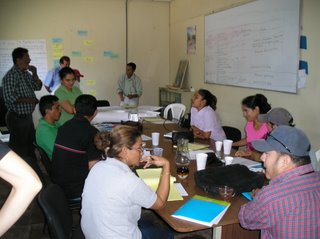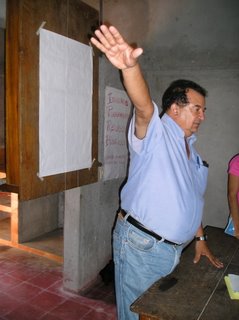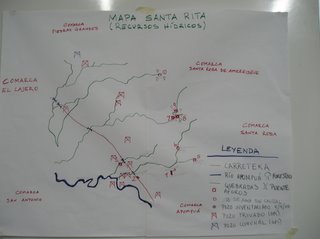Vegetable gardens and water resources
 Had two very busy weeks. And hot too. April is the height of infernal heat in central Nicaragua...
Had two very busy weeks. And hot too. April is the height of infernal heat in central Nicaragua...In any case, I worked with a rural school in starting a vegetable garden. The first team of kids cleared out some very clay rich soil in the playground - these kids know how to wield machetes like kids in the US wield joysticks (are they still called that?) The second team built a structure to plant seeds on. It will protect the seedlings from hungry ants and chickens. We will transplant once the plantlings are strong enough to thrive in the poor soil and be henpecked every so often. The third team of kids ripped off the latrine lid...justice was served since the principal happened to stop by that day.



 I'm involved in a water resource inventory project in a nearby sub watershed near my city. It is led by a Dutch NGO, but with the hopes that the BLM equivalent agency will run with it in setting up their watershed management plan. It will also help farmers in the watershed work together in protecting their water. Representatives from each of the ministries involved in land management were there, and we spent a few days learning about the project and how to do an inventory.
I'm involved in a water resource inventory project in a nearby sub watershed near my city. It is led by a Dutch NGO, but with the hopes that the BLM equivalent agency will run with it in setting up their watershed management plan. It will also help farmers in the watershed work together in protecting their water. Representatives from each of the ministries involved in land management were there, and we spent a few days learning about the project and how to do an inventory.

Here's Freddy explaining to a local group of farmers what the project entails. We needed a small group of farmers to lead us to all surface water sources in and around the community so we could GPS them, and, if possible, measure surface water flow. It is purposely done in the driest part of the year, since scarcity is such an issue here.

Here's Oscar telling people the inventory is the way of the future...or something along those lines.
 Community members making a sketch of the land - later to be used as a field map.
Community members making a sketch of the land - later to be used as a field map.

Here are our volunteers measuring stream flow - there was running water in only two streams, and only in certain points along the way. Our highest flow was 5 gpm. The community relies on wells, since obviously surface water is so scarce in the summertime. In the past, even the wells have dried up, but since there was so much rain this past winter, they aren't hurting too much. One of the shortfalls of the inventory was that, due to complicated well set-ups and time constraints, we couldn't measure well productivity.
 Under the mango tree...most of the river beds suffer from deforestation, so shaded areas like this were scarce. That was one of the conclusions of our inventory - more attention needs to be put into the reforesting the watershed.
Under the mango tree...most of the river beds suffer from deforestation, so shaded areas like this were scarce. That was one of the conclusions of our inventory - more attention needs to be put into the reforesting the watershed. There were a couple of younger guys along for the ride - Pelón (meaning "the bald one") carried our high tech streamflow system.
There were a couple of younger guys along for the ride - Pelón (meaning "the bald one") carried our high tech streamflow system.
 Back at the office working late into the night to complete the maps for presentation to the community. Stress was high as the days were long and I think people felt like there were too many cooks in the kitchen. But we got it done.
Back at the office working late into the night to complete the maps for presentation to the community. Stress was high as the days were long and I think people felt like there were too many cooks in the kitchen. But we got it done.
 Our map...
Our map... Presenting the maps to the three communities in the watershed. There was opportunity at the end for the community members to suggest ways to protect, and better utilize the watershed. A couple of them included re-activating well committees to better maintain wells, and form an integrated committee off all three communities to make their voice heard at the city town-hall. Conservation measures include reforestation, not burning fields, using erosion reducing barriers, and not taking rocks and soil from riverbeds.
Presenting the maps to the three communities in the watershed. There was opportunity at the end for the community members to suggest ways to protect, and better utilize the watershed. A couple of them included re-activating well committees to better maintain wells, and form an integrated committee off all three communities to make their voice heard at the city town-hall. Conservation measures include reforestation, not burning fields, using erosion reducing barriers, and not taking rocks and soil from riverbeds.
One of the main problems was that the farmers that showed up to the meeting were not the people that own the land - most of the land is owned by the city-folk who don't live there. Also, one land owner built a distribution system directly from a spring to bring water to his cows, but now the river has dried up so no one else can benefit from it. As far as I can tell, no one is officially allowed to own water around here, but those with money do.
The national water utility has agreed to test a few wells in the community...it is know that one well has high arsenic, and the people know only to use that well for washing.
 The project ended on Friday, and thankfully we have Semana Santa (Easter week) to recuperate - we have all week off!
The project ended on Friday, and thankfully we have Semana Santa (Easter week) to recuperate - we have all week off!My neighbors gave me one of their dove eggs to eat. Below shows it alongside a regular chicken egg. They taste the same. Nicaraguans don't typically eat dove eggs...it was just lying around.


0 Comments:
Post a Comment
<< Home